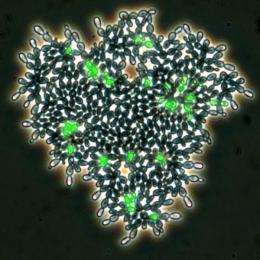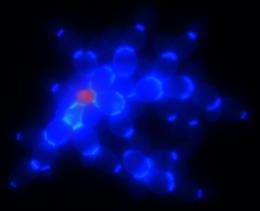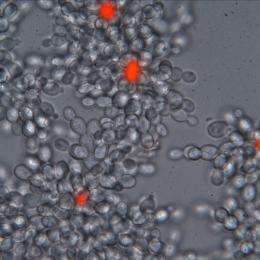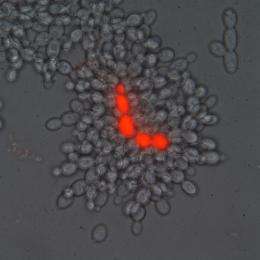Scientists replicate key evolutionary step in life on earth

(PhysOrg.com) -- More than 500 million years ago, single-celled organisms on Earth's surface began forming multi-cellular clusters that ultimately became plants and animals.
Just how that happened is a question that has eluded evolutionary biologists.
Now scientists have replicated that key step in the laboratory using common Brewer's yeast, a single-celled organism.
The yeast "evolved" into multi-cellular clusters that work together cooperatively, reproduce and adapt to their environment--in essence, they became precursors to life on Earth as it is today.
The results are published in this week's issue of the journal Proceedings of the National Academy of Sciences (PNAS).
"The finding that the division-of-labor evolves so quickly and repeatedly in these 'snowflake' clusters is a big surprise," says George Gilchrist, acting deputy division director of the National Science Foundation's (NSF) Division of Environmental Biology, which funded the research.
"The first step toward multi-cellular complexity seems to be less of an evolutionary hurdle than theory would suggest," says Gilchrist. "This will stimulate a lot of important research questions."
It all started two years ago with a casual comment over coffee that bridging the famous multi-cellularity gap would be "just about the coolest thing we could do," recalled Will Ratcliff and Michael Travisano, scientists at the University of Minnesota (UMN) and authors of the PNAS paper.
Other authors of the paper are Ford Denison and Mark Borrello of UMN.
Then came the big surprise: it wasn't that difficult.
Using yeast cells, culture media and a centrifuge, it only took the biologists one experiment conducted over about 60 days.

"I don't think anyone had ever tried it before," says Ratcliff. "There aren't many scientists doing experimental evolution, and they're trying to answer questions about evolution, not recreate it."
The results have earned praise from evolutionary biologists around the world.
"To understand why the world is full of plants and animals, including humans, we need to know how one-celled organisms made the switch to living as a group, as multi-celled organisms," says Sam Scheiner, program director in NSF's Division of Environmental Biology.
"This study is the first to experimentally observe that transition," says Scheiner, "providing a look at an event that took place hundreds of millions of years ago."
In essence, here's how the experiments worked:
The scientists chose Brewer's yeast, or Saccharomyces cerevisiae, a species of yeast used since ancient times to make bread and beer because it is abundant in nature and grows easily.
They added it to nutrient-rich culture media and allowed the cells to grow for a day in test tubes.
Then they used a centrifuge to stratify the contents by weight.
As the mixture settled, cell clusters landed on the bottom of the tubes faster because they are heavier. The biologists removed the clusters, transferred them to fresh media, and agitated them again.

Sixty cycles later, the clusters--now hundreds of cells--looked like spherical snowflakes.
Analysis showed that the clusters were not just groups of random cells that adhered to each other, but related cells that remained attached following cell division.
That was significant because it meant that they were genetically similar, which promotes cooperation. When the clusters reached a critical size, some cells died off in a process known as apoptosis to allow offspring to separate.
The offspring reproduced only after they attained the size of their parents.

"A cluster alone isn't multi-cellular," Ratcliff says. "But when cells in a cluster cooperate, make sacrifices for the common good, and adapt to change, that's an evolutionary transition to multi-cellularity."
In order for multi-cellular organisms to form, most cells need to sacrifice their ability to reproduce, an altruistic action that favors the whole but not the individual, Ratcliff says.
For example, all cells in the human body are essentially a support system that allows sperm and eggs to pass DNA along to the next generation.
Thus multi-cellularity is by its nature very cooperative.
"Some of the best competitors in nature are those that engage in cooperation, and our experiment bears that out," says Travisano.
Evolutionary biologists have estimated that multi-cellularity evolved independently in about 25 groups.
Travisano and Ratcliff wonder why it didn't evolve more often since it's not that difficult to recreate in a lab.
Considering that trillions of one-celled organisms lived on Earth for millions of years, it seems like it should have, Ratcliff says.
That may be a question the biologists will answer in the future using the fossil record for thousands of generations of multi-cellular clusters, which are stored in a freezer in Travisano's lab.
Since the frozen samples contain multiple cell lines that independently became multi-cellular, the researchers can compare them to learn whether similar or different mechanisms and genes were responsible in each case, Travisano says.
The next steps will be to look at the role of multi-cellularity in cancer, aging and other critical areas of biology.
"Multi-cellular yeast is a valuable resource for investigating a wide variety of medically and biologically important topics," Travisano says.
"Cancer was recently described as a fossil from the origin of multi-cellularity, which can be directly investigated with the yeast system.
"Similarly the origins of aging, development and the evolution of complex morphologies are open to direct experimental investigation that would otherwise be difficult or impossible."
More information: Ratcliff, W. C., Denison, R. F., Borrello, M. & Travisano, M. Experimental evolution of multicellularity, Proc. Natl Acad. Sci. dx.doi.org/10.1073/pnas.1115323109 (2012).
Journal information: Proceedings of the National Academy of Sciences
Provided by National Science Foundation


















